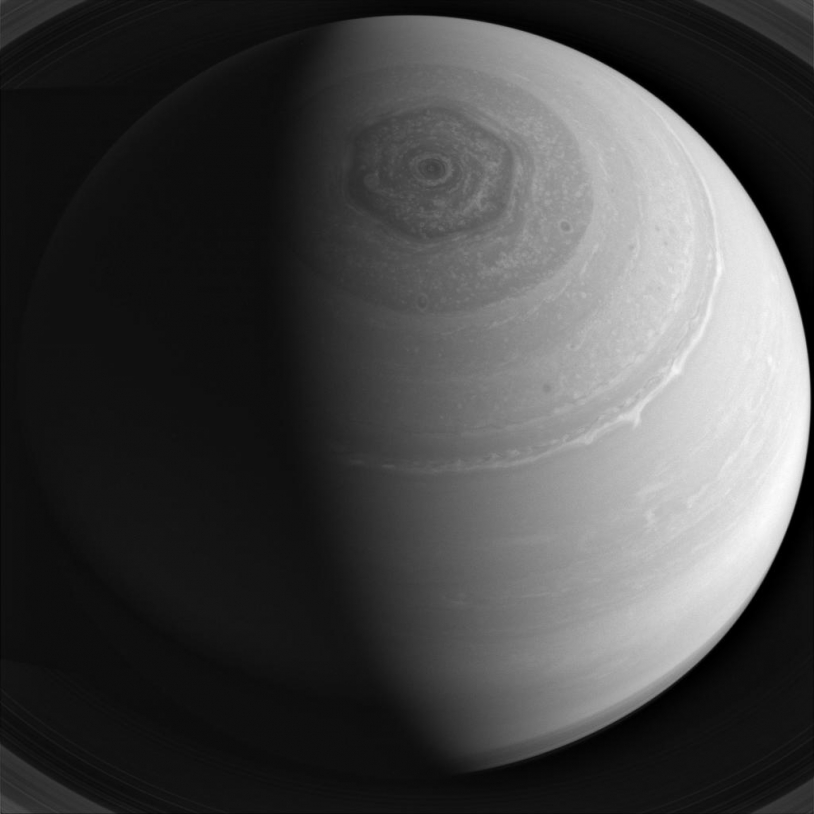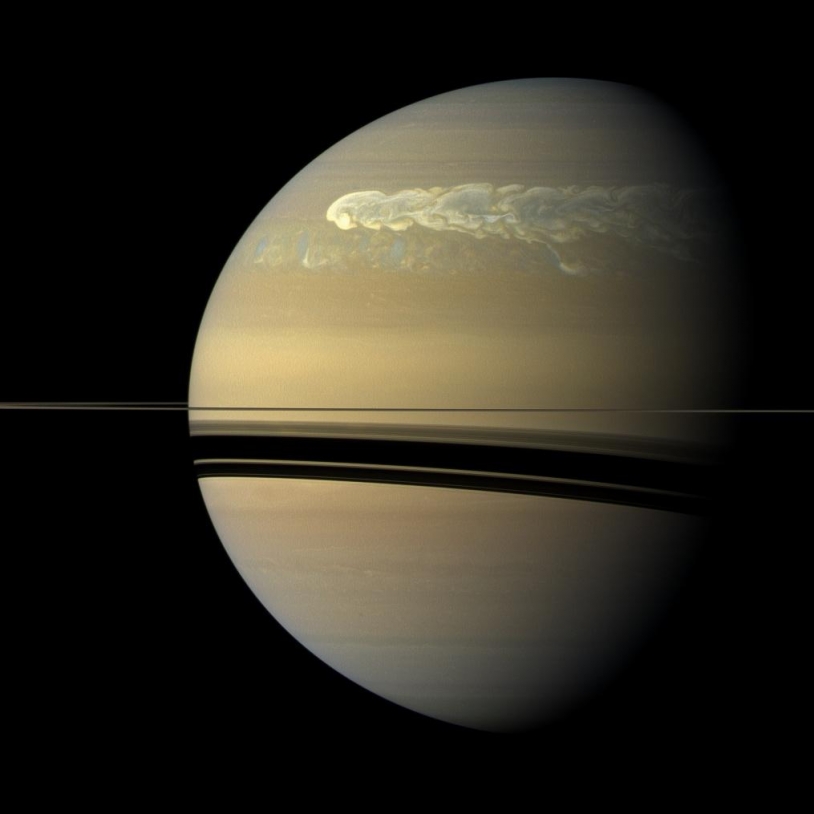Seasons on Saturn
In 13 years Cassini has been able to observe half a year on Saturn—where a year is 30 Earth years long—and see certain seasonal phenomena that can’t be viewed from Earth. “We can only view a single hemisphere at a time, since one is always hidden by the rings,” explains Thierry Fouchet. “To observe both of them simultaneously, we needed a spacecraft in situ. Cassini’s trajectory is ideal, as it passes over the poles, which are hard to view from Earth and where the clearest seasonal contrasts are apparent.”
It is at Saturn’s summer pole that the atmosphere receives the most sunlight, since the Sun never sets there. This contrast is heightened by a kind of very dark soot around the planet’s poles, which is heated in summer and cooled in winter. It is formed of aerosols generated by the very special chemistry of Saturn’s atmosphere, and particle fluxes during aurora borealis events like on Earth.
In comparison, the thermal inertia of our planet’s has oceans mitigates seasonal temperature swings.
“At temperate latitudes, the temperature variations measured by Cassini are largely what we expected to find,” continues Thierry Fouchet, “except in the region of 30° latitude, where it’s warmer in winter than we thought it would be. The rings’ shadows permanently hide the Sun in this region, which is warmer than expected. There must therefore be some kind of redistribution of heat. The finding also proves there’s a meridian circulation transporting heat from the summer hemisphere to the winter hemisphere, which makes for a milder climate.”
All eyes on the hexagon
This unusual structure was first seen 30 years ago by the Voyager mission, and had most certainly been there for much longer. The most surprising thing at first sight is its shape. But for Thierry Fouchet, more surprising still is the fact this hexagon feature is still there after three decades. “On Earth, such dynamic structures die down in a matter of days or weeks. They persist for much longer on the gas giants, like Jupiter’s Great Red Spot, for example. These are extremely stable structures that are very hard to explain from a dynamic perspective, but very interesting to study.”
But why is this feature shaped like it is? The first hypothesis was that an anticyclone initially encircling it shaped its outline. The only snag with this idea is that the anticyclone has since disappeared, but not the hexagon. So where did it come from? According to Thierry Fouchet, a Rossby wave could be the culprit: “One way a fluid responds to stresses is that it generates a wave. Now, Saturn’s atmosphere isn’t uniform and it exhibits density and temperature gradients. That means there’s a northward and then a southward flow, which is also disturbed by Coriolis forces caused by differences in the planet’s rate of rotation at different latitudes. An equilibrium is therefore created and the circular wave may take the form of a hexagon.”
Watching the giant storm up close
In December 2010, Cassini offered a front-row seat for a massive storm in Saturn’s atmosphere, a convective storm caused by rising warm, moist air. This storm cell remained visible for seven months in the shape of a Great White Spot and an enormous plume.
“The convective plume was almost as large as Earth and most certainly 100 kilometres or so deep. Once it reached the top of the atmosphere, it encircled the planet, forming a long white band.”
This phenomenon had already been viewed from Earth before and appeared to occur once every 30 years or so, the length of a Saturnian year. It is therefore likely also a seasonal phenomenon. But thanks to Cassini, this was the first time the storm was observed at close quarters for such a long period, during which the spacecraft detected up to 10 lightning flashes per second. “That proves there’s convection going on and water clouds, since water is what best conducts electricity. Cassini watched the storm forming in the planet’s deep atmosphere, the troposphere to be precise, and then propagating to the surface. Higher up, the stratosphere was heated considerably over several months, resulting in a hot spot like a ‘beacon’ visible in the infrared.”
A familiar atmospheric picture
Studying different planets also gives us the opportunity to learn more about our own Earth. The dynamics in the stratosphere 30 kilometres above our heads are very different to what we see on the ground: two winds blow in an easterly and westerly direction, reversing every 26 months.

Figure: Zonal winds in Earth’s stratosphere. At a given altitude, westerly winds (red) and easterly winds (blue) reverse every 26 months or so. © 2001 by the American Geophysical Union. 8755-1209/01/1999RG000073$15.00 Reviews of Geophysics, 39, 2 / May 2001 pages 179-229
“Here we’re talking about a phenomenon that has nothing to do with sunlight and seasons,” Thierry Fouchet continues. “Air rises along the equator by convection from the bottom of the troposphere to below the stratosphere, at an altitude of around 16 kilometres in the tropopause that marks the end of the troposphere, above which the temperature increases with altitude. This is what stops convection and causes the stratosphere to vibrate like the skin of a drum. The waves propagate upwards, causing the winds to oscillate. The winds on Saturn behave in exactly the same way. Stratospheric dynamics obey the same laws from one planet to another. It’s of course great to make new discoveries, but it’s also useful to note that these mechanisms are universal.”
And while Cassini hasn’t detected any new gases in Saturn’s atmosphere that scientists didn’t already know about, it has been able to study their spatial and seasonal distribution, finding for example that benzene is more plentiful at the poles than at the equator. But for Thierry Fouchet, a key mystery remains: how much helium there is. “It’s the second most abundant gas in the atmosphere after hydrogen, but we still don’t know exactly how much of it there is. It’s a noble gas, meaning it’s chemically unreactive and has a weak spectral signature. Because of that, any attempts to measure it result in sometimes contradictory error bars. The only way we can do it is to descend into Saturn’s atmosphere, so in that respect Cassini’s Grand Finale is going to be a great opportunity to make some final discoveries.”
More information
Science contacts
- Francis Rocard, Head of CNES’s solar system programme francis.rocard at cnes.fr
- Thierry Fouchet, lecturer at Pierre et Marie Curie University (UPMC) and research scientist at the Paris Observatory thierry.fouchet at obspm.fr


